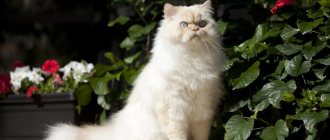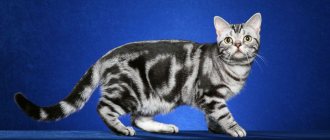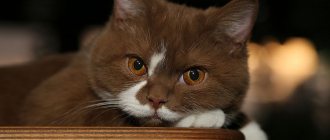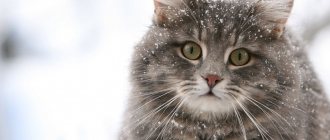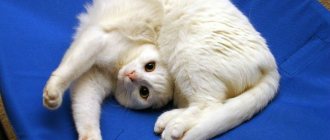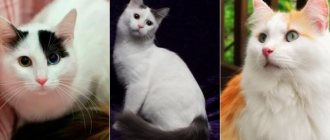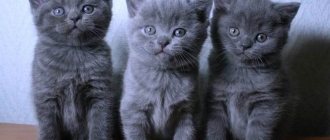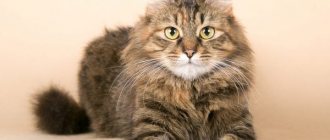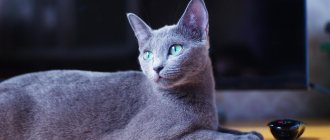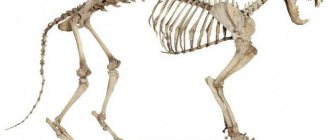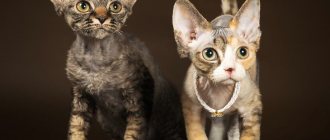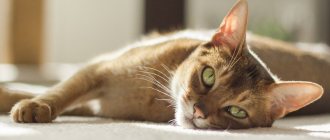Origin story
The country of origin of the Abyssinian breed is the now extinct Abyssinia, located in the northern part of Africa. It is believed that the breed was obtained as a result of the domestication of wild African cats about 2 thousand years ago. Images of animals similar to the Abyssinian breed are found on ancient frescoes in the tombs of the pharaohs.
The exact date of formation of the breed is unknown. These exotic pets appeared in Europe at the end of the 19th and beginning of the 20th centuries. The first representatives of Abyssinians were seen at exhibitions in England, and at that time they still had a striped color and tufts on the ears. With the development of the breed, these signs gradually disappeared from the appearance of Egyptian cats.
The English name for Abyssinian cats is Abyssinian. It has several standards for various classifications - for example, according to FiFe and WCF, Abyssinians are assigned category III (shorthair).
Health and illness
Even with the best care, your pet can get sick. As for the Abyssinian breed, they suffer from multiple hereditary diseases.
What does an Abyssinian suffer from?
- Hyperesthesia syndrome - the cat suffers from increased pain sensitivity and reacts inadequately to touch.
- Atrophy of the retina, as a result of which the pet can become completely blind.
- Dislocation of the knee joints.
- Kidney pathologies leading to loss of appetite and constipation or diarrhea.
- Allergic reactions are common to food.
- Gum diseases. Abyssinians are prone to gum disease.
In this regard, Abyssinian cats need an annual preventive check, which costs approximately 1,500 - 3,500 rubles.
Characteristics of the Abyssinian breed
More than a century has passed since the appearance of the Abyssinian breed in Europe to the present day. Throughout this time, the breed gradually underwent its formation, changing its appearance with each generation. The cats of our time are noticeably different from the first “migrants” from Egypt. Here are the main characteristics that describe the current standards for Abyssinians.
Standard
- Head: wedge-shaped, with smooth, rounded outlines.
- Body: medium size, with developed muscles, long legs and tail, the body is quite powerful.
- Weight: an adult varies from 4 to 7 kg.
- Ears: large with rounded tips, the fur on which is noticeably darker.
- Eyes: almond-shaped, large, expressive, the rim of the eyelids is dark, forming a kind of “eyeliner”. Eye color can be green or yellow, taking on various shades.
- Coat: short, fine, lies close to the body and has a pronounced shine. However, the main feature of Abyssinian wool is its unique color, achieved by ticking. The concept of “ticking” means that each hair in the fur has stripes (usually 2-3) of different colors, due to which all the fur on the animal’s body receives beautiful smooth tints of color.
- Average age: with good care, Abyssinians can live on average up to 15-20 years.
The World Cat Owners Association (CFA) officially recognizes four color variants for this breed:
- wild (ruddy) – black ticking on a red-brown base;
- red – brown ticking on an apricot-colored base;
- blue – gray-blue tints on apricot-colored wool;
- beige (fawn) – beige-pink stains on ivory.
It is characteristic that when crossing individuals with different colors, the kittens never get a mixed color - they inherit the color variant that is genetically dominant.
Health
Like all purebred animals, Abyssinians are susceptible to certain diseases, the predisposition to which is determined by their genetics. Such diseases include:
- polycystic kidney disease;
- blood diseases;
- gingivitis;
- problems with the gastrointestinal tract;
- feline leukemia.
Genetic diseases in this breed can be easily diagnosed using a genetic test, thereby avoiding offspring with unwanted health problems. Other conditions, such as gastrointestinal and oral diseases, can be managed with careful care and regular visits to the veterinarian.
Today there is a vaccine against feline leukemia, after which the pet is protected from the fatal disease.
Thus, all health problems of Abyssinians are completely solvable, and with proper attention to the pet they can be easily avoided.
Character
Abyssinian cats are living and active animals . They are quite willful , but at the same time remain people-oriented and value attention and care. However, they remain independent and learn the rules of behavior in the house quite gradually.
Abyssinians are intelligent enough to learn to go to the litter box, eat at a certain time and point their claws in a specially designated place, but they require a separate corner in the house where they will carry toys and exist, being left to their own devices. These pets love to climb into different places, explore space and play with other animals. They can be kept with other medium to large sized pets, but they usually instinctively hunt rodents.
When leaving an Abyssinian cat with a child, be careful, as this capricious animal does not tolerate familiarity towards itself - explain to the child (if this is possible due to age) that you cannot roughly touch your pet or take away his toys and food. If this is not possible, then it is better not to leave your pet alone with the baby .
Abyssinian cats are relatively easy to handle, they are not the most timid or finicky breed, but they can growl and hiss in unusual or stressful situations.
Possible problems
The Abyssinian cat is relatively easy to handle, so there are no direct contraindications for keeping such a pet. Cats of this breed are very bored without their owner , therefore, if the owner disappears for a long time at work, it is recommended to have two cats at once, or a cat and a dog.
In addition, Abyssinians love to play and move objects , so if the potential owner is not ready to pay a lot of attention to the cat and engage it in active games, it is better to take a closer look at more “lazy” pets.
Interesting Facts
Their unusual coat has always aroused admiration, but a lot of interesting facts are associated with the colors of Abyssinians:
- In the 19th century and early next, the fur of these cats was called "rabbit" because of the dark tips and corresponding texture.
- The Abyssinians introduced the cinnamon color to the British cat breed.
- There are swamp cats in Africa that have identical ticking and coat types, but are predominantly gray and larger in size.
- Abyssinians do not have the usual “necklace” of stripes in the neck area, as well as the pattern above the bridge of the nose.
- On the tips of the ears in many colors there should be a spot resembling a blurred fingerprint.
- All main colors of Abyssinian cats are based on black pigment (eumelanin), that is, there are no genetically red animals in this breed.
- Despite the previous point, there are no completely black Abyssinians.
An important factor is that it is very difficult to determine the exact color type of an Abyssinian kitten. Until the age of 3, they change their coat and change colors, especially cats.
Photos of colors
red (sorrel)
wild
blue
beige (faun)
Care
Abyssinians in general are not a problematic breed in terms of care , however, there are some nuances that the owner should observe when keeping such cats.
Wool
Caring for the coat of Abyssinian cats is as simple as possible . The Abyssinian's coat is little subject to shedding due to the virtual absence of undercoat; the cat is very clean and does not require special care measures. Their fur is short and smooth, so they do not require frequent brushing. It is enough to brush your cat once every 1-2 weeks with a fine-toothed metal brush. Before exhibitions, you can run a piece of natural suede over the Abyssinian’s fur - this will smooth the fur and make it even smoother and shiny in appearance.
You can bathe an Abyssinian cat as needed (if the pet gets dirty), or once every few months. Cats of this breed easily tolerate contact with water, do not scratch or run away. You need to wash your cat with a special shampoo for short and smooth hair.
Nutrition
There is no special diet for Abyssinian cats , but it is recommended to feed them a combination of dry and wet food designed for this breed. It is especially important to follow this recommendation to prevent gingivitis and digestive disorders, which pets of this breed are prone to. The rating of the best wet food can be found in our article.
Ear care
For Abyssinian cats, special ear care is required, because... they are prone to infection. Once every two weeks, your pet’s ears should be wiped with a cotton pad soaked in boiled warm water. The pet's teeth also need special attention - it is necessary to regularly (once every 3-4 months) examine the cat's oral cavity at the veterinarian.
Walking your pet
It is important for Abyssinians to move a lot and find new objects to explore. In a small apartment, such a cat will feel constrained and will not have enough space to play.
The best option for an Abyssinian cat to live is a spacious country house, in the yard of which the cat needs to be regularly walked on a harness. It is not recommended to let your pet go for independent walks, because... The curiosity of this breed can take it far from home.
Character
Abyssinians are active and inquisitive animals, striving to understand the world around them. They retain such passion and playfulness until old age. Representatives of the breed are smart, balanced, intelligent and affectionate. They are not prone to aggression, do not use their claws during games, and are patient with children, even if they do not know how to show love.
Abyssinian cats do not sit still and are constantly looking for something to do. They love to sit on cabinets and watch their household.
Representatives of the breed are clean and neat. They do not damage property, do not chew plants or rummage through flower pots, do not ride on chandeliers or use curtains as a Swedish slide.
Breeders advise not to let cats out onto balconies and to close the windows. Natural curiosity pushes Abyssinians to act recklessly - they can easily jump from a height of the seventh floor after a pigeon, which is fraught with dire consequences. Porcelain, crystal and any fragile items should be removed from view.
Abyssinians are endowed with self-esteem and will not tolerate disrespectful treatment. Cats prefer to sit next to a person and only occasionally climb onto their laps.
Owners compare their pets to dogs: they are just as loyal, playful and easy to train. For example, an Abyssinian can be trained to fetch small thrown objects. bringing abandoned items.
Cats do not abandon kittens; they feed and raise their offspring without outside help.
Representatives of the breed need human love and attention. Physical and visual contact with the owner is important for them; without this, cats develop depression and psychosomatic disorders.
Breed card
| Characteristics of a cat | Notes | |
| General information | Comes in different colors. Kittens are quite easy to acquire | Small litters |
| Character | Playful cats, quite capricious and inquisitive, adore the company of people. | |
| Appearance | Quite an exotic appearance, especially if the cats have tufts on their ears | |
| Behavior at home | They become attached to the house and owner, love active games and climbing. | Usually gets along well with dogs, but should not be trusted with small rodents and birds. It is better not to leave children alone with a cat for a long time. |
| Care | Smooth coat requires almost no grooming | |
| Health problems | Feline leukemia | Vaccination against this deadly disease is necessary |
Sorrel
The second name is red, but among Abyssinians it is not a standard color, like other cats have a red color. It is generally accepted that the close color of the sorrel is a variation of cinnamon (the coat is lighter than chocolate and the nose is necessarily in pinkish-brown shades of varying intensity).
Distinctive features of the Sorrel color:
- Coat color ranges from copper-red to brown with a hint of red.
- The undercoat and roots are a rich apricot color.
- The awns are brown with red or copper at the ends.
- Ticking – red-brown zones of varying saturation.
- The nose is a muted reddish hue with a dark outline.
- Paw pads are dusty pink.
Designation of the name in the pedigree – Red, Сynnamon, color code – Aby (o).
How to choose a kitten
The cost of an Abyssinian cat kitten, depending on the pedigree and color, ranges from 10,000 to 50,000 rubles . In some cases, kittens from reputable breeders are sold at a price of 80,000 rubles, depending on the class of the kitten.
Pet class are kittens with defects in appearance, which are prohibited from being used for breeding.
Breeding class - cats acceptable for mating, but not for participation in exhibitions.
Show class - kittens with a desirable appearance that can become participants in exhibitions.
The most expensive kittens are the top show class. They are distinguished by their impeccable appearance and flexible character. They are the ones who determine the future of the breed and are desirable for mating.
The best age to buy a kitten is 12 weeks and older . At this age, the kitten can already be weaned from its mother and undergoes all the necessary medical procedures, so it can be taken home without fear.
It is better to choose kittens from reputable breeders or nurseries. By 3 months, the kitten should have 2 vaccination marks. The cat's passport must indicate the pedigree. Pay attention to whether your kitten is intended for breeding the breed (such kittens are significantly more expensive) and how many inbred matings are in its pedigree (preferably no more than 4).
Feeding
The diet for such breeds can be based on both natural products and industrial feed. The main thing is to choose the type of feeding right away, so as not to torment the animal and not transfer it to another product.
Natural nutrition
The Abyssinian’s natural diet includes almost all the delicacies from your table:
- meat (can be raw or cooked) - chicken, turkey, beef;
- fish (preferably sea) – boneless and boiled;
- eggs (mostly quail);
- vegetables (both raw and boiled are suitable) - beets, carrots, zucchini, broccoli;
- fruits – pear, apples.
You can add special vitamins to your food.
Industrial feed
The problem here will be in choosing high-quality food that will not harm your pupil.
Recommended treats from the following manufacturers:
- Royal Canin Exigent 33.
- Guabi Natural.
- Grandorf Adult Cat Indoor Lamb {amp}amp; Rice Hypoallergenic.
Portions are calculated individually, taking into account the weight of the animal.
